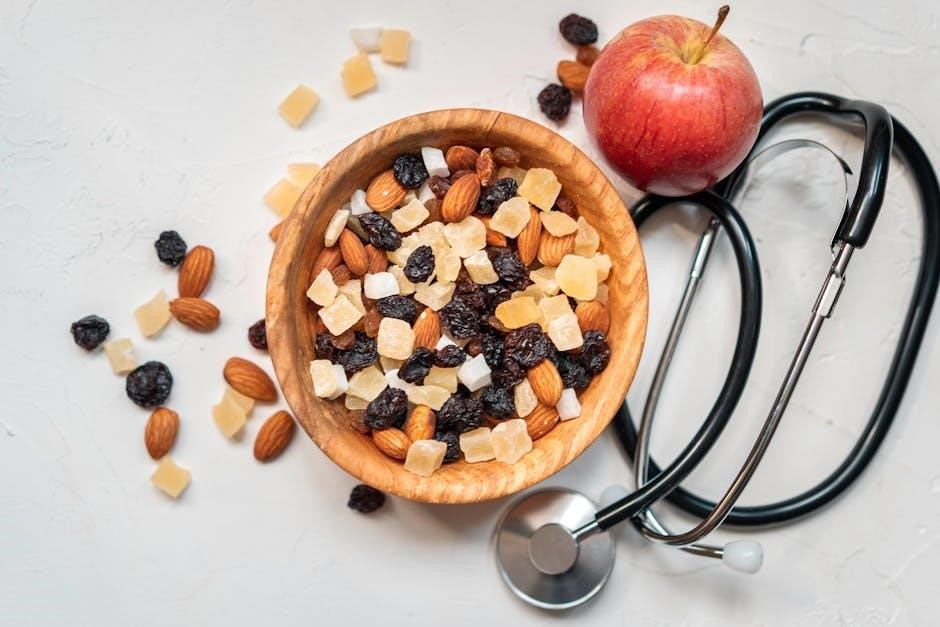A protein diet plan focuses on increasing protein intake to support weight loss, muscle growth, and overall health․ It emphasizes lean proteins, whole foods, and balanced nutrition․
What is a Protein Diet Plan?
A protein diet plan is a dietary approach that emphasizes the consumption of high amounts of protein while often limiting other macronutrients like carbohydrates and fats․ It typically involves focusing on lean protein sources such as chicken, fish, eggs, legumes, tofu, and low-fat dairy products․ The plan is designed to support various health and fitness goals, including weight loss, muscle building, and improved blood sugar control․ By prioritizing protein-rich foods, individuals aim to enhance satiety, boost metabolism, and maintain muscle mass․ The diet encourages whole, nutrient-dense foods and often requires careful meal planning to ensure adequate protein intake without overconsumption․ It is adaptable to different lifestyles and goals, making it a popular choice for those seeking a structured nutritional framework․

Why Choose a High-Protein Diet?
A high-protein diet is chosen for its numerous health benefits, including weight management, muscle preservation, and improved metabolic function․ Protein helps increase satiety, reducing hunger and calorie intake, which is beneficial for weight loss․ It also supports muscle repair and growth, making it ideal for athletes and those engaging in regular physical activity․ Additionally, high-protein diets can help stabilize blood sugar levels, improving overall health and reducing the risk of chronic diseases․ With its focus on nutrient-dense foods, a high-protein diet promotes a balanced and sustainable eating pattern, making it a popular choice for individuals seeking long-term health and wellness․ Its versatility allows it to be tailored to various dietary preferences and lifestyles, ensuring it meets diverse nutritional needs effectively․
How to Get Started with a Protein Diet Plan
Starting a protein diet plan begins with setting clear goals, such as weight loss or muscle building․ Calculate your daily protein needs based on your weight, activity level, and objectives․ Incorporate a variety of protein-rich foods like lean meats, fish, eggs, legumes, and dairy into your meals․ Plan balanced meals and snacks, ensuring each contains a protein source․ Track your intake using a food diary or app to stay on target․ Consider consulting a nutritionist for a personalized plan tailored to your lifestyle and preferences․ Gradually adjust your diet to avoid drastic changes and ensure sustainability․ Pair protein with healthy carbs and fats for balanced nutrition․ This structured approach helps you stay motivated and achieve your goals effectively․

Benefits of a High-Protein Diet
A high-protein diet supports weight management, muscle maintenance, and improved blood sugar control․ It enhances satiety, reducing hunger and promoting a feeling of fullness, while supporting overall health․
Weight Loss and Fat Reduction
A high-protein diet is widely recognized for its effectiveness in weight loss and fat reduction․ Protein requires more energy to digest compared to carbohydrates or fats, boosting metabolism and helping burn calories․ It also increases satiety, reducing overall calorie intake by making you feel fuller longer․ Studies show that diets rich in lean proteins, such as chicken, fish, and plant-based options, lead to significant fat loss while preserving muscle mass․ Additionally, protein helps stabilize blood sugar levels, preventing cravings for unhealthy snacks․ Combining a high-protein intake with a calorie-controlled diet and regular physical activity can accelerate weight loss and improve body composition․ This approach is particularly effective for those aiming to shed pounds and maintain a leaner physique over time․
Muscle Building and Maintenance
A high-protein diet is essential for muscle building and maintenance, as protein provides the necessary amino acids for muscle repair and growth․ When combined with resistance training, adequate protein intake stimulates muscle protein synthesis, leading to increased muscle mass․ Athletes and bodybuilders often consume 1․2–2․2 grams of protein per kilogram of body weight daily to support their training goals․ Additionally, protein helps preserve muscle tissue during weight loss, ensuring that fat is burned rather than muscle․ Foods like lean meats, fish, eggs, and plant-based proteins are ideal for supporting muscle health․ Consistency in protein intake and proper training are key to achieving and maintaining a strong, lean physique over time․
Improved Blood Sugar Control
A high-protein diet can help regulate blood sugar levels by slowing the digestion of carbohydrates and reducing insulin spikes․ Protein takes longer to break down than carbs, providing a steady release of glucose into the bloodstream․ This stabilizes blood sugar levels and prevents sharp fluctuations, which is particularly beneficial for individuals with diabetes or prediabetes․ Lean protein sources like chicken, fish, and plant-based options such as legumes are ideal for maintaining blood sugar balance․ Additionally, pairing protein with complex carbs can further enhance glucose control․ Incorporating protein-rich meals and snacks into your diet can help manage blood sugar effectively, promoting overall metabolic health and reducing the risk of complications associated with unstable blood sugar levels․
Enhanced Satiety and Reduced Hunger
A high-protein diet can significantly enhance satiety and reduce hunger by keeping you feeling fuller for longer․ Protein requires more energy to digest than carbohydrates or fats, which slows down digestion and prolongs feelings of fullness․ This can lead to fewer cravings and a natural reduction in overall calorie intake․ Studies suggest that protein-rich meals suppress hunger hormones like ghrelin and increase satiety hormones such as leptin, making it easier to stick to your diet plan․ Incorporating protein into every meal helps maintain energy levels and prevents midday crashes, ensuring sustained satisfaction and focus throughout the day․ This makes high-protein diets particularly effective for weight management and improving eating habits․

Creating a Personalized Protein Diet Plan
A personalized protein diet plan tailors intake to individual goals, dietary needs, and lifestyle․ Assess current protein intake, set realistic targets, and balance with carbs and fats․
Setting Your Protein Goals
Setting clear protein goals is essential for a successful diet plan․ Start by determining your daily protein needs based on your weight, activity level, and dietary objectives․ For most adults, 0․8–1․2 grams of protein per kilogram of body weight is recommended․ If you’re aiming for weight loss or muscle building, adjust your intake accordingly․ Consider your lifestyle—active individuals may require more protein to support muscle repair․ Additionally, assess your overall health and any dietary restrictions․ Tailor your goals to align with your long-term vision, whether it’s improving fitness, managing weight, or enhancing overall nutrition․ Consulting a healthcare professional or nutritionist can provide personalized guidance․ A well-defined protein goal ensures you stay focused and motivated on your dietary journey․
Understanding Your Caloric Needs
Understanding your caloric needs is crucial for a protein diet plan․ Your daily calorie intake depends on factors like age, weight, height, and activity level․ Aim for a balance that supports your goals, whether weight loss or muscle maintenance․ For example, a plan might include 150 grams of protein, 200 grams of carbohydrates, and 70 grams of fat․ However, individual needs vary, so precise calculations are necessary․ Tracking your intake helps maintain the right balance and prevents deficiencies․ Remember, excess calories, even from protein, can hinder progress․ Regularly adjust your plan based on your body’s response and consult a nutritionist for personalized advice to ensure long-term success․
Considering Your Activity Level and Lifestyle
Your activity level and lifestyle play a crucial role in shaping your protein diet plan․ Active individuals, especially those engaging in regular exercise or sports, typically require more protein to repair and build muscle tissue․ Sedentary individuals may need less protein but still benefit from a balanced intake․ Factors like age, weight, and specific health goals also influence protein needs․ For example, someone aiming for weight loss may adjust their protein intake to support fat reduction while maintaining muscle mass․ Incorporating high-protein foods like lean meats, fish, and legumes into meals can help meet these needs; Additionally, meal prepping and scheduling protein-rich snacks can accommodate busy lifestyles, ensuring consistent nutrition throughout the day․ Tailoring your protein intake to your unique circumstances is key to achieving your health and fitness goals․

Food Choices for a High-Protein Diet
Focus on lean meats, fish, eggs, legumes, and low-fat dairy․ Incorporate plant-based proteins like tofu and quinoa․ Avoid processed and high-fat options for optimal health benefits․
Lean Protein Sources: Chicken, Fish, and Eggs
Lean protein sources like chicken, fish, and eggs are cornerstone components of a high-protein diet․ Chicken breast is an excellent low-fat option, rich in essential amino acids․ Fish, such as salmon and cod, provides omega-3 fatty acids along with protein, supporting heart health․ Eggs are versatile and packed with high-quality protein, making them a great breakfast or snack option․ These foods are ideal for weight management and muscle repair․ Incorporating variety ensures a balanced intake of nutrients․ Opt for grilled, baked, or steamed preparations to avoid added fats․ Including these lean proteins in meals helps maintain satiety and supports overall dietary goals․ They are also versatile, fitting easily into breakfast, lunch, or dinner plans․
Plant-Based Proteins: Legumes, Tofu, and Quinoa
Plant-based proteins like legumes, tofu, and quinoa are excellent options for those following a vegetarian or vegan diet․ Legumes, such as lentils and chickpeas, are rich in protein and fiber, making them highly nutritious․ Tofu, derived from soybeans, is a versatile and protein-dense food that absorbs flavors well, making it ideal for various dishes․ Quinoa is unique as a complete grain, providing all essential amino acids․ These foods are not only great for protein intake but also offer additional health benefits, including improved digestion and reduced inflammation․ Incorporating them into meals ensures a balanced diet without relying on animal products․ They are also environmentally friendly and cost-effective, making them a sustainable choice for high-protein meal planning․

Dairy and Low-Fat Options: Greek Yogurt and Cottage Cheese
Dairy products like Greek yogurt and cottage cheese are excellent low-fat, high-protein options for a balanced diet․ Greek yogurt is rich in probiotics, supporting gut health, while cottage cheese provides casein protein, which aids in muscle recovery․ Both are versatile and can be incorporated into meals or snacks․ They are ideal for those seeking to maintain muscle mass while managing fat intake․ These dairy options are also low in calories, making them suitable for weight management․ Additionally, they are rich in calcium, essential for bone health․ Incorporating these into your protein diet plan can enhance overall nutrition and provide sustained energy throughout the day․ They are also great bases for adding fruits, nuts, or spices for added flavor and nutrients․
Avoiding Processed and High-Fat Proteins
Processed and high-fat proteins, such as sausages and fried meats, should be minimized in a protein diet plan․ These foods often contain unhealthy additives, excess sodium, and saturated fats, which can lead to weight gain and health issues․ Opting for lean, unprocessed protein sources ensures better nutritional benefits without the negative effects․ Limiting these foods helps maintain a balanced intake of nutrients, supporting overall health and weight management goals․ Choosing natural, low-fat protein options promotes a healthier and more effective diet plan․

Meal Planning Strategies
Meal planning strategies involve creating structured schedules for breakfast, lunch, and dinner, ensuring balanced nutrition and sufficient protein intake․ Incorporate snacks and vary protein sources daily․
Breakfast Ideas High in Protein
Starting your day with a high-protein breakfast can boost metabolism and energy levels․ Try a Greek yogurt parfait with berries and granola, or scrambled eggs with spinach and feta․ Avocado toast topped with a poached egg is another nutritious option․ For a quick meal, blend a protein smoothie with spinach, banana, and almond milk․ Chia pudding made with coconut milk and topped with nuts is a healthy choice․ Smoked salmon on whole-grain bagels with cream cheese also provides a protein-packed start․ These meals are not only delicious but also help maintain muscle and curb hunger throughout the morning․
Lunch and Dinner Options for Balanced Nutrition
Lunch and dinner are crucial meals for maintaining energy and satisfying nutritional needs․ Incorporate lean proteins like grilled chicken, turkey, or fish, paired with complex carbs such as quinoa, brown rice, or whole-grain pasta․ Add a variety of colorful vegetables like spinach, broccoli, or bell peppers for essential vitamins and fiber․ A balanced meal might include baked salmon with sweet potatoes and steamed greens or a stir-fry with tofu, mixed vegetables, and brown rice․ Ensure portion control to meet your protein and caloric goals․ Hydration is also key, so drink water throughout the day․ These meals provide sustained energy and support overall health, aligning with a high-protein diet plan․
Healthy Snacking to Maintain Protein Intake
Snacking is a great way to maintain protein intake throughout the day․ Choose nutrient-dense options like nuts, seeds, Greek yogurt, or hard-boiled eggs․ These snacks are rich in protein and can curb hunger between meals․ For plant-based options, consider edamame, hummus with veggies, or protein-rich smoothies․ Avoid processed snacks high in sugar or unhealthy fats․ Instead, opt for whole foods that provide sustained energy and support your dietary goals․ Balancing snacks with protein, healthy fats, and complex carbs ensures you stay satisfied and energized․ Incorporating these snacks into your protein diet plan helps maintain consistency and prevents overeating at main meals․ Always portion control to align with your daily protein and caloric needs․

Monitoring Your Progress
Regularly track your protein intake, weight, and measurements to assess your progress․ Adjust your diet based on results and maintain a consistent routine for optimal success․
Tracking Your Protein Intake
Tracking your protein intake is essential for ensuring you meet your daily goals and maintain consistency․ Use a food diary or mobile app to record every meal and snack, noting the protein content of each item․ This helps identify gaps and makes adjustments easier․ For example, if your target is 150 grams of protein per day, logging each serving of chicken, fish, or legumes will keep you accountable․ Additionally, measuring portion sizes and referencing nutritional labels can enhance accuracy․ Regularly reviewing your logs allows you to celebrate progress and make necessary tweaks to stay on track․ Over time, this habit fosters a better understanding of your dietary habits and supports long-term success․
Adjusting Your Diet Based on Results
As you track your progress, it’s essential to reassess your protein diet plan regularly․ If your weight loss or muscle-building goals aren’t being met, consider increasing or decreasing protein portions․ Experiment with new recipes to keep meals interesting and ensure you’re meeting your nutritional needs․ Pay attention to how your body responds—adjustments might be necessary to maintain energy levels or address any deficiencies․ Consulting with a nutritionist can provide personalized insights to fine-tune your diet․ Remember, consistency is key, but flexibility ensures long-term success․ By making thoughtful adjustments based on your results, you can optimize your high-protein diet for better health outcomes and sustained motivation․
The Importance of Regular Health Check-Ups
Regular health check-ups are crucial for ensuring your protein diet plan is working effectively and safely․ Monitoring key metrics like blood sugar levels, cholesterol, and kidney function can help identify potential issues early․ A healthcare provider can assess whether your high-protein intake is balanced with other nutrients, preventing deficiencies or strain on vital organs; Additionally, check-ups provide an opportunity to discuss any physical changes or concerns, such as energy levels or digestion, which may require adjustments to your diet․ Staying proactive about your health ensures long-term success and helps maintain motivation․ By combining a well-planned protein diet with regular medical evaluations, you can achieve a healthier lifestyle confidently․

Common Mistakes to Avoid
Avoid excessive protein intake, neglecting carbohydrates and fats, and insufficient hydration․ Ensure balanced nutrition and stay hydrated for optimal results and overall health benefits․
Overconsumption of Protein
Overconsumption of protein can lead to potential health risks, such as kidney strain and dehydration; Diets excessively high in protein may also result in an imbalanced intake of essential nutrients like carbohydrates and fats․ It is important to avoid relying solely on high-protein foods and to monitor daily protein intake to prevent long-term health complications․ Additionally, consuming too much protein can sometimes lead to weight gain if the overall caloric intake exceeds your body’s needs․ A balanced approach ensures that protein intake aligns with individual goals and health requirements․ Always consult a healthcare professional or nutritionist to determine the right amount of protein for your specific needs․
Neglecting Other Nutrients Like Carbohydrates and Fats
Neglecting carbohydrates and fats while focusing solely on protein can lead to nutritional deficiencies and health issues․ Carbohydrates provide essential energy for daily activities, while fats support hormone production and the absorption of certain vitamins․ A diet lacking in these nutrients may result in fatigue, decreased performance, and impaired bodily functions․ It’s important to maintain a balanced diet that includes whole grains, fruits, vegetables, and healthy fats to ensure overall well-being; Consulting a nutritionist can help create a protein diet plan that incorporates all necessary nutrients for optimal health and sustainability․
Not Drinking Enough Water
Staying hydrated is essential, especially on a high-protein diet, as water aids in protein digestion and overall bodily functions․ Dehydration can lead to muscle cramps, fatigue, and impaired physical performance․ Even mild dehydration can reduce focus and energy levels, hindering weight loss and muscle-building goals․ Drinking insufficient water may also strain the kidneys, which work harder to process protein․ Aim for at least eight glasses of water daily, adjusting for activity levels․ Incorporate water-rich foods and monitor urine color to ensure proper hydration․ Neglecting water intake can undermine the benefits of a protein diet, making it crucial to prioritize hydration for optimal health and performance․

Sustainability and Long-Term Results
Maintaining a High-Protein Diet Long-Term
A sustainable protein diet plan ensures long-term health benefits by balancing protein intake with other nutrients, preventing boredom, and adapting to lifestyle changes gradually․
Maintaining a high-protein diet long-term requires consistency and adaptability․ Focus on incorporating a variety of lean protein sources, such as chicken, fish, legumes, and dairy, to keep meals interesting and nutritious․ Meal planning is crucial to ensure sustained protein intake without relying on processed foods․ Staying hydrated and monitoring your body’s response to the diet are equally important․ Over time, adjust portion sizes and food choices based on progress and health goals․ A balanced approach that includes whole foods and mindful eating habits will help make the high-protein diet a sustainable lifestyle choice, promoting long-term health and well-being․
Staying Motivated and Consistent
Staying motivated on a protein diet plan requires setting realistic goals and tracking progress․ Celebrate small achievements, like increasing protein intake or maintaining consistency․ Meal prepping and planning can help avoid unhealthy choices․ Surround yourself with supportive friends or join a community for encouragement․ Remind yourself of the benefits, such as improved energy and health․ Consistency is key to long-term success, so focus on sustainable habits rather than quick fixes․ Regularly reviewing your progress and adjusting your plan can keep you engaged․ Stay positive and patient, as results may take time to appear․ A well-structured and enjoyable approach ensures adherence to your protein diet plan․
Gradually Transitioning to a Balanced Diet
Transitioning from a high-protein diet to a balanced diet involves gradually incorporating more variety․ Start by introducing complex carbs and healthy fats to meals․ Incorporate whole grains, fruits, and vegetables to diversify your nutrition․ This helps maintain satiety and ensures you’re getting essential vitamins and minerals․ Plan meals that include a mix of protein, carbs, and fats for sustained energy․ Avoid drastic changes to prevent cravings or nutrient deficiencies․ Listen to your body and adjust the transition pace as needed․ A balanced diet supports long-term health and prevents reliance on a single nutrient source․ This approach fosters a sustainable and enjoyable eating routine․
A high-protein diet plan can effectively support weight loss, muscle growth, and improved health․Balanced nutrition and consistency are key to achieving and maintaining long-term results․
Final Thoughts on the Protein Diet Plan
A well-structured protein diet plan can be an effective way to achieve weight loss, build muscle, and improve overall health․ By focusing on lean proteins, whole grains, and balanced nutrition, individuals can create a sustainable eating pattern․ It’s important to consult with a healthcare professional or nutritionist to tailor the plan to specific needs․ Remember, a successful diet isn’t just about high protein but also about variety, moderation, and long-term consistency․ Pairing protein with healthy fats and carbohydrates ensures a balanced intake of nutrients․ Regular health check-ups and tracking progress can help maintain motivation and ensure the diet’s effectiveness․ Ultimately, a protein diet plan is a versatile tool for achieving and maintaining a healthier lifestyle․
Next Steps for a Healthier Lifestyle
Adopting a protein diet plan is just the beginning of your journey toward better health․ Start by incorporating small, achievable changes into your daily routine, such as meal prepping or keeping a food diary․ Gradually increase your physical activity to complement your dietary efforts, focusing on exercises that align with your lifestyle․ Staying hydrated and ensuring adequate sleep are also crucial for optimal results․ Consider consulting a nutritionist to personalize your plan further․ Track your progress regularly and celebrate milestones to stay motivated․ Remember, consistency is key, and patience will yield long-term benefits․ By combining a balanced diet with mindful habits, you can create a sustainable path to wellness․
Resources for Further Reading and Planning
For a deeper understanding and effective planning, explore reliable resources like the NHS Choices 12-week guide, which offers structured meal plans and weight loss tips․ Websites such as nutrition․gov and healthline․com provide detailed articles on high-protein diets, including recipes and expert advice․ Downloadable PDF guides, such as those from the American Heart Association, can help you create balanced meal plans tailored to your needs․ Mobile apps like MyFitnessPal and YAZIO are excellent tools for tracking your protein intake and staying organized․ Additionally, consult with a registered dietitian or healthcare professional for personalized guidance․ These resources will empower you to make informed decisions and maintain a sustainable protein diet plan․